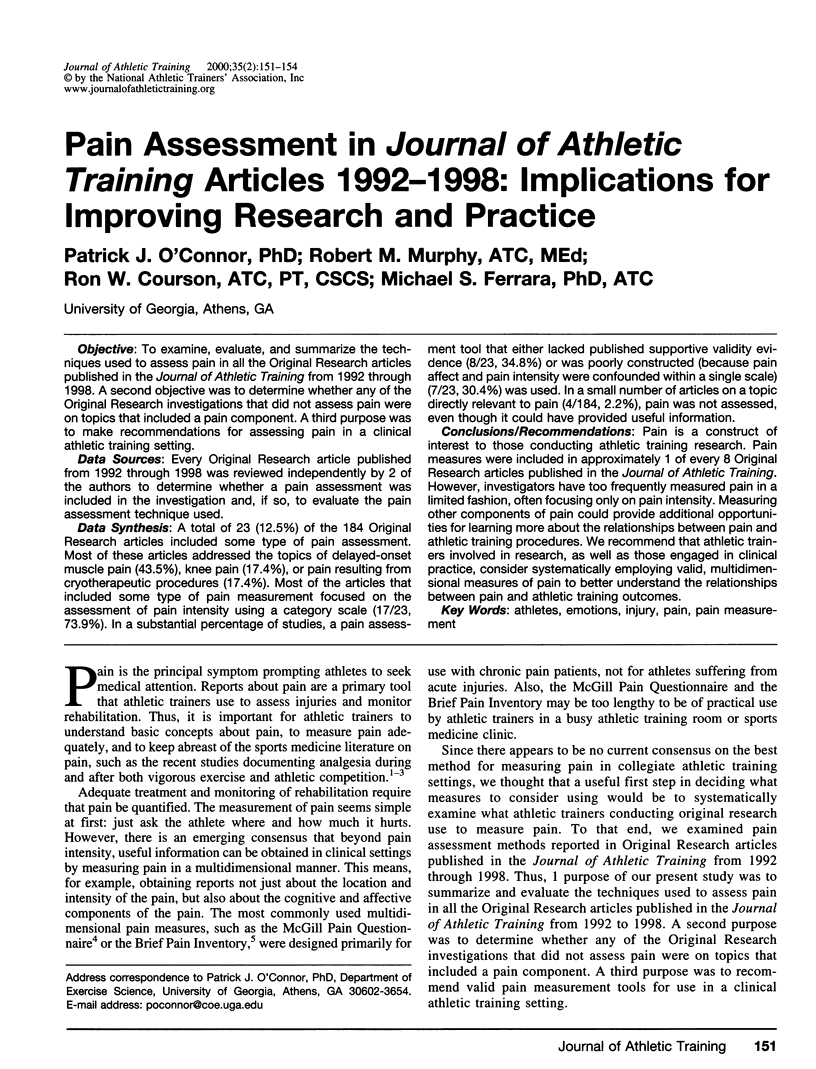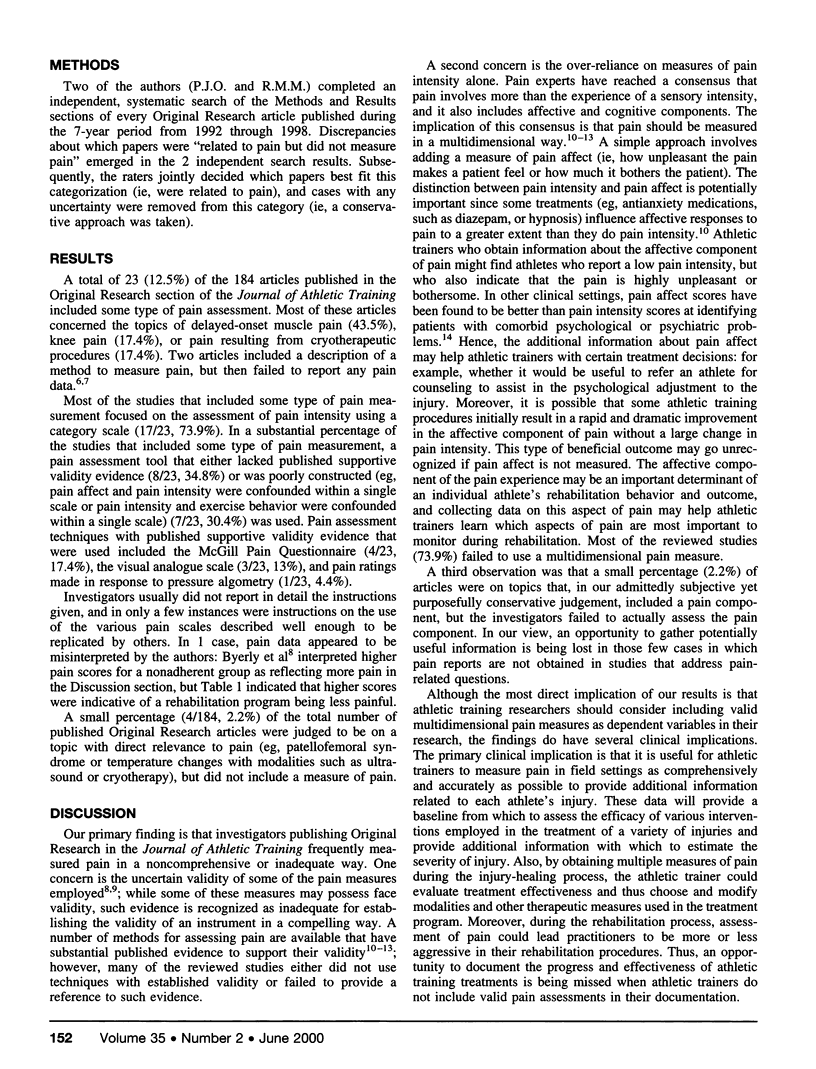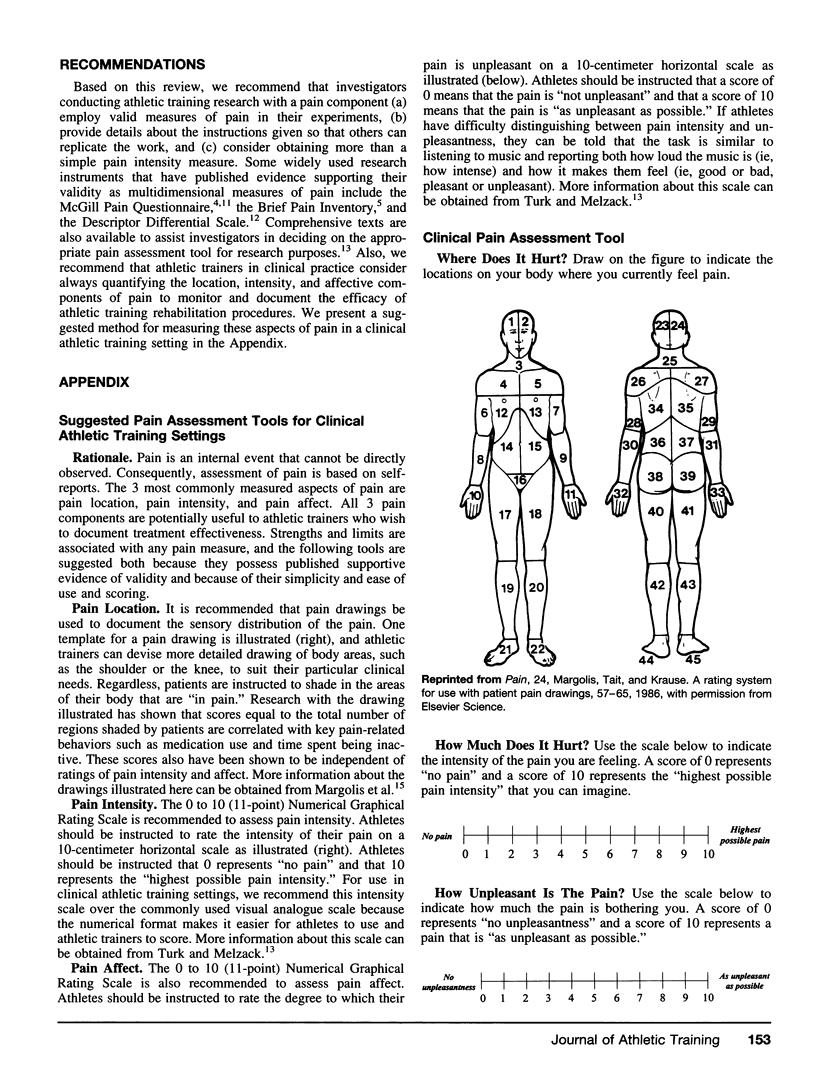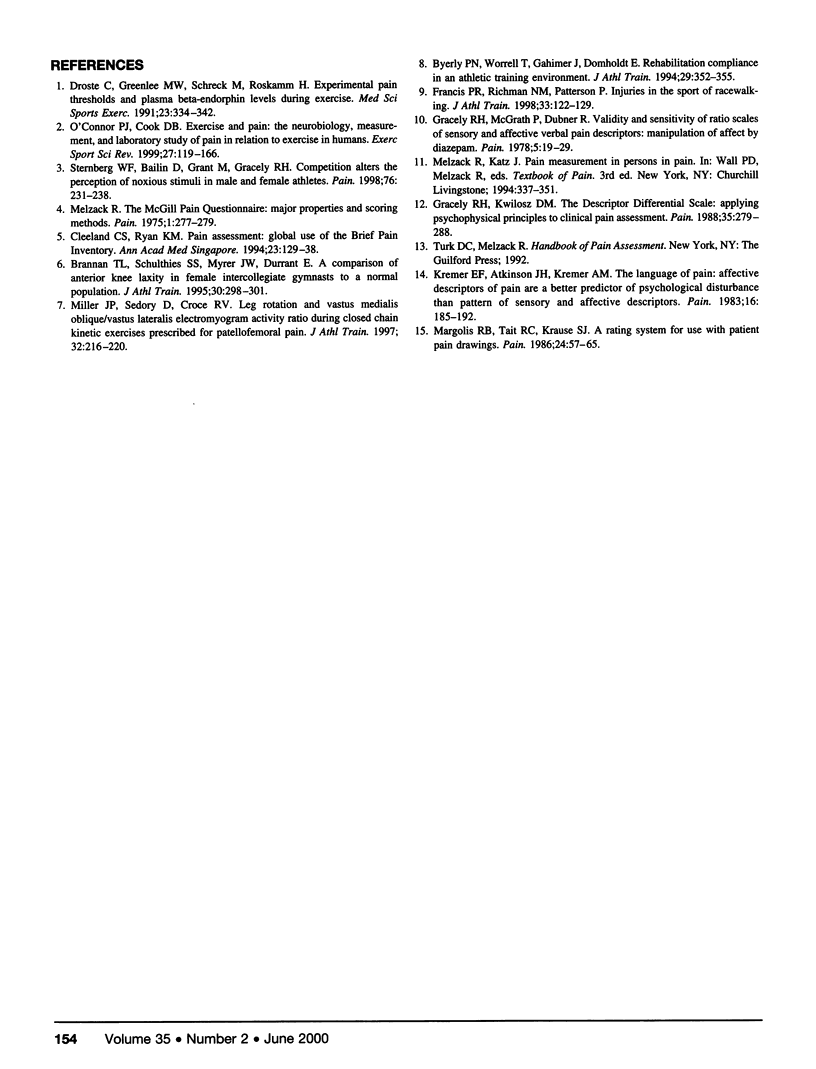Abstract
Objective:
To examine, evaluate, and summarize the techniques used to assess pain in all the Original Research articles published in the Journal of Athletic Training from 1992 through 1998. A second objective was to determine whether any of the Original Research investigations that did not assess pain were on topics that included a pain component. A third purpose was to make recommendations for assessing pain in a clinical athletic training setting.
Data Sources:
Every Original Research article published from 1992 through 1998 was reviewed independently by 2 of the authors to determine whether a pain assessment was included in the investigation and, if so, to evaluate the pain assessment technique used.
Data Synthesis:
A total of 23 (12.5%) of the 184 Original Research articles included some type of pain assessment. Most of these articles addressed the topics of delayed-onset muscle pain (43.5%), knee pain (17.4%), or pain resulting from cryotherapeutic procedures (17.4%). Most of the articles that included some type of pain measurement focused on the assessment of pain intensity using a category scale (17/23, 73.9%). In a substantial percentage of studies, a pain assessment tool that either lacked published supportive validity evidence (8/23, 34.8%) or was poorly constructed (because pain affect and pain intensity were confounded within a single scale) (7/23, 30.4%) was used. In a small number of articles on a topic directly relevant to pain (4/184, 2.2%), pain was not assessed, even though it could have provided useful information.
Conclusions/Recommendations:
Pain is a construct of interest to those conducting athletic training research. Pain measures were included in approximately 1 of every 8 Original Research articles published in the Journal of Athletic Training. However, investigators have too frequently measured pain in a limited fashion, often focusing only on pain intensity. Measuring other components of pain could provide additional opportunities for learning more about the relationships between pain and athletic training procedures. We recommend that athletic trainers involved in research, as well as those engaged in clinical practice, consider systematically employing valid, multidimensional measures of pain to better understand the relationships between pain and athletic training outcomes.
Keywords: athletes, emotions, injury, pain, pain measurement
Full text
PDF



Selected References
These references are in PubMed. This may not be the complete list of references from this article.
- Brannan T. L., Schulthies S. S., Myrer J. W., Durrant E. A comparison of anterior knee laxity in female intercollegiate gymnasts to a normal population. J Athl Train. 1995 Oct;30(4):298–301. [PMC free article] [PubMed] [Google Scholar]
- Byerly P. N., Worrell T., Gahimer J., Domholdt E. Rehabilitation compliance in an athletic training environment. J Athl Train. 1994 Dec;29(4):352–355. [PMC free article] [PubMed] [Google Scholar]
- Cleeland C. S., Ryan K. M. Pain assessment: global use of the Brief Pain Inventory. Ann Acad Med Singapore. 1994 Mar;23(2):129–138. [PubMed] [Google Scholar]
- Droste C., Greenlee M. W., Schreck M., Roskamm H. Experimental pain thresholds and plasma beta-endorphin levels during exercise. Med Sci Sports Exerc. 1991 Mar;23(3):334–342. [PubMed] [Google Scholar]
- Francis P. R., Richman N. M., Patterson P. Injuries in the sport of racewalking. J Athl Train. 1998 Apr;33(2):122–129. [PMC free article] [PubMed] [Google Scholar]
- Gracely R. H., Kwilosz D. M. The Descriptor Differential Scale: applying psychophysical principles to clinical pain assessment. Pain. 1988 Dec;35(3):279–288. doi: 10.1016/0304-3959(88)90138-8. [DOI] [PubMed] [Google Scholar]
- Gracely R. H., McGrath P., Dubner R. Validity and sensitivity of ratio scales of sensory and affective verbal pain descriptors: manipulation of affect by diazepam. Pain. 1978 Jun;5(1):19–29. doi: 10.1016/0304-3959(78)90021-0. [DOI] [PubMed] [Google Scholar]
- Kremer E. F., Atkinson J. H., Kremer A. M. The language of pain: affective descriptors of pain are a better predictor of psychological disturbance than pattern of sensory and affective descriptors. Pain. 1983 Jun;16(2):185–192. doi: 10.1016/0304-3959(83)90207-5. [DOI] [PubMed] [Google Scholar]
- Margolis R. B., Tait R. C., Krause S. J. A rating system for use with patient pain drawings. Pain. 1986 Jan;24(1):57–65. doi: 10.1016/0304-3959(86)90026-6. [DOI] [PubMed] [Google Scholar]
- Melzack R. The McGill Pain Questionnaire: major properties and scoring methods. Pain. 1975 Sep;1(3):277–299. doi: 10.1016/0304-3959(75)90044-5. [DOI] [PubMed] [Google Scholar]
- Miller J. P., Sedory D., Croce R. V. Leg rotation and vastus medialis oblique/vastus lateralis electromyogram activity ratio during closed chain kinetic exercises prescribed for patellofemoral pain. J Athl Train. 1997 Jul;32(3):216–220. [PMC free article] [PubMed] [Google Scholar]
- O'Connor P. J., Cook D. B. Exercise and pain: the neurobiology, measurement, and laboratory study of pain in relation to exercise in humans. Exerc Sport Sci Rev. 1999;27:119–166. [PubMed] [Google Scholar]
- Sternberg W. F., Bailin D., Grant M., Gracely R. H. Competition alters the perception of noxious stimuli in male and female athletes. Pain. 1998 May;76(1-2):231–238. doi: 10.1016/s0304-3959(98)00050-5. [DOI] [PubMed] [Google Scholar]


